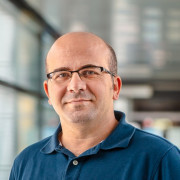Education:
ד"ר חיים טרבס
CV
Education:
Research Interests
We explore the tremendous potential of algal metabolic diversity
Photosynthesis shaped much of the world as we know it, driving our climate, nutrition and energy resources. Fueled by energy and reducing power generated by the light reactions, metabolic pathways in photosynthetic cells have evolved to optimally divide fixed carbon between growth, storage and other cellular and organismal needs (which is often termed “photosynthate investment”), and when needed, to alleviate stress caused by imbalances thereof (e.g. under fluctuating conditions).
The theoretical limit of photosynthesis efficiency (defined as the fraction of light energy that is captured in conversion of CO2 and water to glucose) is widely accepted as ~12%, but reaches only 3-4% in higher plants and 5-7% in microalgae in empirical efficiencies measurements, emphasizing the potential of the latter as a resource of improvement of photosynthesis in future crops.
Our overreaching aim is to gain deep systems-level understanding of photosynthetic metabolism in algae, and the role it plays in stirring photosynthesis efficiency and growth. To address these goals, we apply a set of tools, including state-of-the-art flux-metabolomics, modeling, molecular biology and physiology.
Publications
1. Treves, H., Küken, A., Arrivault, S., Ishihara, H., Hoppe, I., Erban, A., Höhne, M., Moraes, T.A., Kopka, J., Szymanski, J., Nikoloski, Z. and Stitt, M. (2021). Carbon flux through photosynthesis and central carbon metabolism show distinct patterns between algae, C3 and C4 plants. Nat Plants, https://doi.org/10.1038/s41477-021-01042-5.
2. Luo, X., Wu, W., Feng, L., Treves, H. and Ren, M. (2021) Short Peptides Make a Big Difference: The Role of Botany-Derived AMPs in Disease Control and Protection of Human Health. Int J Mol Sci. 22(21):11363.
3. Caspy, I., Neumann, E., Fadeeva, M., Liveanu, V., Savitsky, A., Frank, A., Kalisman, Y.L., Shkolnisky, Y., Murik, O., Treves, H., Hartmann, V., Nowaczyk, M.M., Schuhmann, W., Rögner, M., Willner, I., Kaplan, A., Schuster, G., Nelson, N., Lubitz, W. and Nechushtai. R. (2021) Cryo-EM photosystem I structure reveals adaptation mechanisms to extreme high light in Chlorella ohadii. Nat Plants. 7(9):1314-1322.
4. Kedem, I., Treves, H.*, Noble, G., Hagemann, M., Murik, O., Raanan, H., Oren, N., Giordano, M., Kapan, A. (2020) Keep your friends close and your competitors closer: Novel interspecies interaction in desert biological sand crusts. Phycologia. DOI: 10.1080/00318884.2020.1843349.
*Corresponding author.
5. Treves, H., Siemiatkowska, B., Luzarowska, U., Murik, O., Fernandez Pozo, N., Alexandre Moraes, T., Erban, A., Armbruster, U., Brotman, Y., Kopka, J., Rensing, S., Szymanski, J., and Stitt, M. (2020). Multi-omics reveals mechanisms of total resistance to extreme illumination of a desert alga. Nat Plants. 6:1031-1043.
6. Treves, H., Murik O., Kedem, I., Eisenstadt, D., Meir, S., Rogachev, I., Szymanski, J., Keren, N., Orf, I., Tiburcio, A. F., Alcázar, R., Aharoni, A., Kopka, J. and Kaplan, A. (2017). Metabolic flexibility underpins growth capabilities of the fastest growing alga. Curr Biol. 27:2559-2567.
7. Murik, O., Oren N., Shotland Y., Raanan, H., Treves, H., Kedem, I., M., Hagemann M., Pade, N., and Kaplan, A. (2016). What distinguishes cyanobacteria able to resurrect after desiccation from those that cannot: The genome aspect. Environ Microbiol. 19:535-550.
8. Raanan, H., Oren N., Treves, H., Keren, N., Ohad, I., Berkowicz, S., M., Hagemann M., Koch, M., Shotland Y., and Kaplan, A. (2016). Towards clarifying what distinguishes cyanobacteria able to resurrect after desiccation from those that cannot: The photosynthetic aspect. BBA - Bioenergetics. 1857:715-722.
9. Raanan, H., Oren N., Treves, H., Berkowicz, S.M., Hagemann M., Keren, N., Kaplan, A (2015) Simulated soil crust conditions in a chamber system provide new insights on cyanobacterial acclimation to desiccation. Environ Microbiol. 18:414-426
10. Treves, H., Raanan, H., Kedem, I., Murik, O., Keren, N., Ohad, I., Zer, H., Berkowicz, S., Giordano, M., Norici, A., Shotland Y., Ohad, I., and Kaplan, A. (2016) The mechanisms whereby the green alga Chlorella ohadii, isolated from desert soil crust, exhibits unparalleled photodamage resistance New Phytologist. 210:1229-1243.
*Science Editor's Choice and F1000 recommended
11. Raanan H., Felde J. M. N. L.V., Peth S., Drahorad S., Ionescu D., Eshkol G., Treves H., Felix-Henningsen P., Berkowicz S.M., Keren N., Horn R., Hagemann M., Kaplan A. (2015) Three-dimensional structure and cyanobacterial activity within a desert biological soil crust. Environ Microbiol. 18:372-383
12. Treves, H., Raanan H., Finkel O., Berkowicz S., Keren, N., Kaplan, A. (2013) A newly isolated Chlorella sp. from desert sand crusts exhibits a unique resistance to excess light intensity. FEMS Microbiol Ecol. 86(3):373-80.
13. Rilov, G., Treves, H. (2010) Climate change effects on marine ecological communities. In: Alvaro, I., Einav, R., Seckbach, J. Seaweeds and their role in globally changing environments. Springer, Dordrecht, pp. 51-68.
14. Rilov, G., Treves, H. (2010) Climate change effects on marine ecological communities: Global perspectives and implications in Israel marine environment. Ecology & Environment, 1:57-65.
Awards\Scholarships
2022-2025 Alon Young Faculty Fellowship, Council for Higher Education in Israel
2018-2021 Human Frontier Science Program (HFSP) for Postdoctoral Researchers for 36 months research residency at the Max-Planck Institute of Molecular Plant Physiology
2020 EPPN2020 - European Plant Phenotyping Network - full funding for algal phenotyping project, in INRA/Bordeaux.
2018-2020 Humboldt Research Fellowship Programme for Postdoctoral Researchers for 24 months research residency at the Max-Planck Institute of Molecular Plant Physiology






